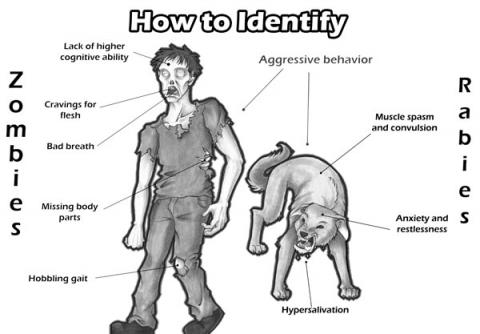-
Table of Contents
- 0. STORY PREFACE
- 1. RABIES - WHAT'S in a NAME?
- 2. RABIES in ANCIENT TIMES
- 3. WHAT IS RABIES?
- 4. LOUIS PASTEUR - EXPERIMENTER
- 5. LOUIS PASTEUR MEETS JOSEPH MEISTER
- 6. A TEEN HERO NAMED JEAN-BAPTISTE JUPILLE
- 7. LOUIS PASTEUR - WORLDWIDE BENEFACTOR
- 8. RABIES as a 21st-CENTURY PROBLEM
- 9. RABIES and ZOMBIES
 Back
Back
 Next Chapter
Next Chapter
This graphic, comparing the physical characteristics of zombies and of an animal with rabies, is online from the CDC (Centers for Disease Control).
Facing the same type of dilemma Pasteur and his team faced with Joseph Meister, Dr. Rodney Willoughby and his Milwaukee team ventured down a previously untried path to save their patient.
At least Pasteur and his colleagues had been successful with dogs. The Milwaukee team was guided by a theory never-before been attempted on humans or animals.
In a deep coma, kept alive by artificial life support, the Milwaukee patient now faced the risk of death from two separate sources. She could die from rabies or she could die from the powerful drugs which the doctors gave her.
With the medical team constantly monitoring her condition, several weeks went by. The patient’s blood samples showed that her body was producing antibodies which were fighting the rabies.
The anti-rabies plan seemed to be working, but would she be able to survive her comatose condition?
When the doctors slowly brought their patient out of her coma, they began to worry if they had saved her from rabies but had simultaneously caused a locked-in condition (in which the patient’s brain and mind were functioning but her body was not).
Fortunately, the Milwaukee athlete survived. However, she faced a very difficult recovery since she had to relearn walking, talking, running and living in general.
The same “Milwaukee Protocol” has reportedly saved about five patients (not including the first, or "index" survivor) who faced similar issues, but doctors around the world are not-yet sure whether the procedure will be effective for everyone.
They worry whether the successful attempts are “merely anecdotal” (as that phrase is used in such cases) or actually predictive of future, repeated success. Beyond that, not all physicians even accept that the surviving Milwaukee-Protocol patients actually had rabies.
Time will tell what the future holds for people who either have no access to the vaccine or who do not receive it before symptoms develop.
Given how many individuals die each year from rabies, particularly children in Asia and Africa, we can only hope that some of the world’s resources will be used to develop an effective treatment plan in the very-near future.
Beyond the impact which rabies has on human lives, it is also alive and well in the culture. The next time you watch a Zombies movie, view a Zombies-based TV series or read a novel which features Zombies (or werewolves or similar creatures), ask yourself this question:
What did rabies have to do with inspiring such stories?
If you dig into the background, you will discover the answer is ... a lot, actually! After all ... the symptoms are similar (as depicted in the graphic above) and, as the authors of a 2013 study (led by a UC-Irvine team) tell us:
Zombie popularity may be a perfect opportunity to increase awareness of rabies.

-
Table of Contents
- 0. STORY PREFACE
- 1. RABIES - WHAT'S in a NAME?
- 2. RABIES in ANCIENT TIMES
- 3. WHAT IS RABIES?
- 4. LOUIS PASTEUR - EXPERIMENTER
- 5. LOUIS PASTEUR MEETS JOSEPH MEISTER
- 6. A TEEN HERO NAMED JEAN-BAPTISTE JUPILLE
- 7. LOUIS PASTEUR - WORLDWIDE BENEFACTOR
- 8. RABIES as a 21st-CENTURY PROBLEM
- 9. RABIES and ZOMBIES
 Back
Back
 Next Chapter
Next Chapter



